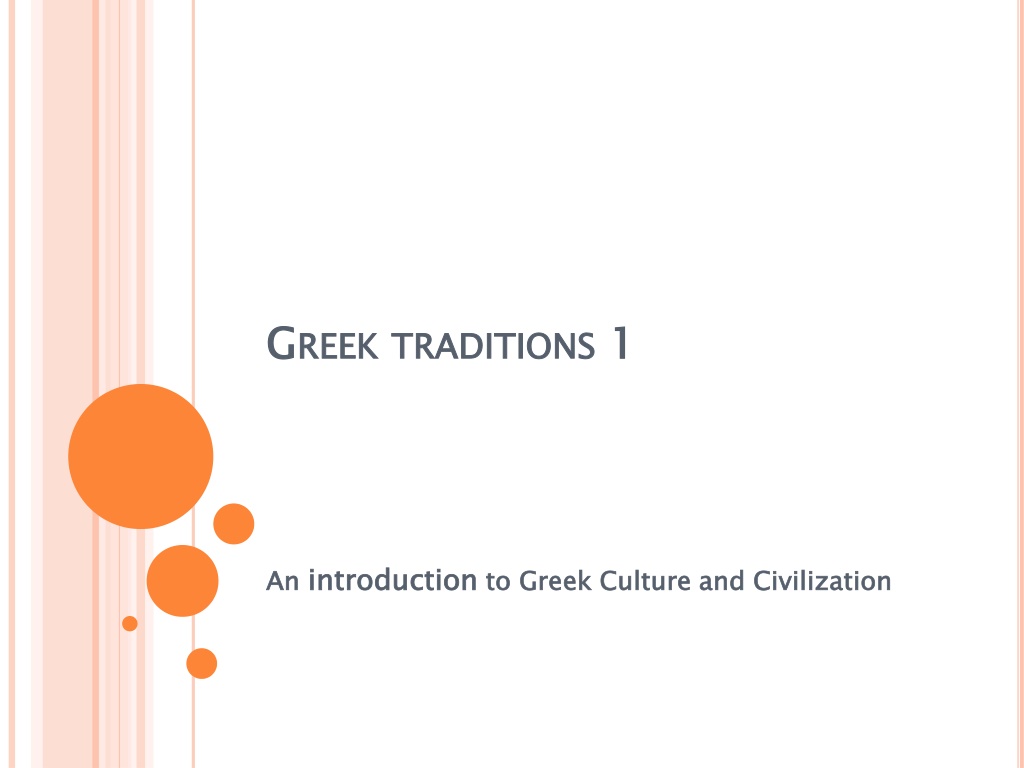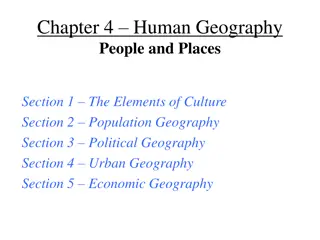Insights into Greek Culture, Geography, and Population
Explore the rich cultural heritage, diverse geographical features, and unique demographic characteristics of Greece. Discover its geographical position, neighboring countries, physical borders, land composition, geographical regions, and population demographics including language and religion.
Download Presentation

Please find below an Image/Link to download the presentation.
The content on the website is provided AS IS for your information and personal use only. It may not be sold, licensed, or shared on other websites without obtaining consent from the author. Download presentation by click this link. If you encounter any issues during the download, it is possible that the publisher has removed the file from their server.
E N D
Presentation Transcript
G GREEK TRADITIONS 1 1 REEK TRADITIONS An introduction introduction to Greek Culture and Civilization An to Greek Culture and Civilization
THE GEOGRAPHICAL POSITION OF GREECE IN THE WORLD MAP https://maps.google.sk/maps?oe=utf- 8&client=firefox- a&channel=sb&q=greece+maps&ie=UTF- 8&hq=&hnear=0x135b4ac711716c63:0x363a1775dc9a 2d1d,%CE%95%CE%BB%CE%BB%CE%AC%CE%B4%CE%B1&gl =sk&ei=YOgFU7HNHoiMswbA4ICgAQ&ved=0CDYQ8gE wAA Greece is located on: - the south-eastern end of Europe - the southern end of the Balkan Peninsula - the point where Europe meets Asia and Africa Greece is located on:
NEIGHBOUR-COUNTRIES o Albania o FYROM o Bulgaria o Turkey
o Evros River (Turkey) o Rhodope Mountain Range (Bulgaria) o Doiran Lake (FYROM) o Big Prespa Lake (FYROM-Albania) o Small Prespa Lake (Albania) o Ionian Sea (Italy) o Mediterranean Sea (Libya & Egypt) o Aegean Sea (Turkey) PHYSICAL BORDERS
CHARACTERISTICS OF THE GREEK LANDSCAPE o Total area: 132.049 km2, of which 0,86% is WATER o Approximately half of the total area is covered by ISLANDS o Most of the mainland of Greece is mountainous o Fishery, international trade (besides agriculture and cattle-breeding) o Colonization all around the Mediterranean Sea
GEOGRAPHICAL REGIONS OF GREECE Greece is divided in 9 geographical regions: Thrace Macedonia Thessaly Epirus Central Greece Peloponnese Aegean Islands Ionian Islands Crete & 51 prefectures
CHARACTERISTICS OF THE GREEK POPULATION o Population: 10.816.286 (2011), of which 91,6% are Greek, 4% Albanians and 2% other ethnic groups o Official Language: Greek o Religion: Orthodox (88,1%) Muslims (5,3%) others (0,5%) Atheists (6,1%) (2015) o Lingual & religious homogeneity
CHARACTERISTICS OF THE GREEK STATE Polity: Presidential Parliamentary Republic Member of the United Nations Member of the North Atlantic Treaty Organization (NATO) (1951) Member of the European Union (EU) (1979- 1981) Member of the Euro Zone Replacement of drachma with euro (2001)

















































